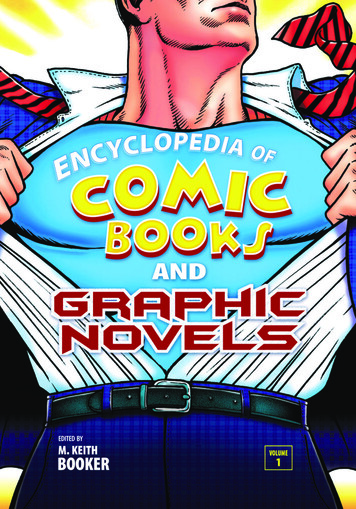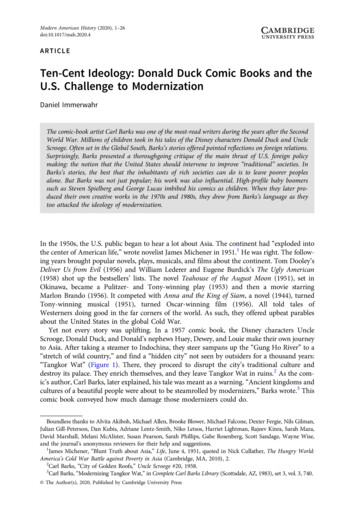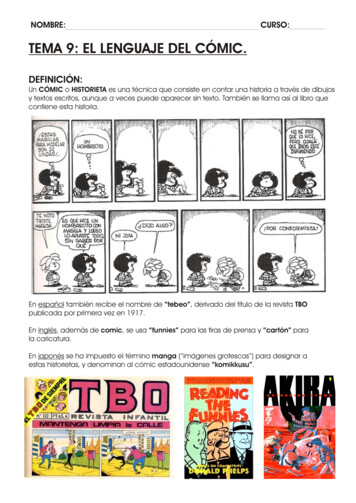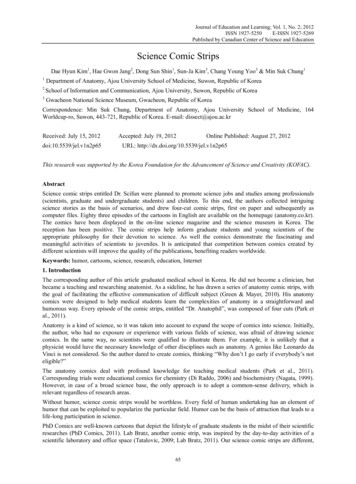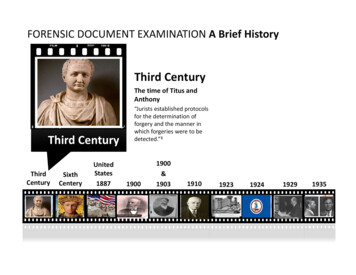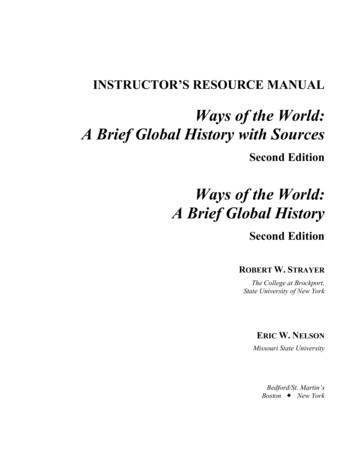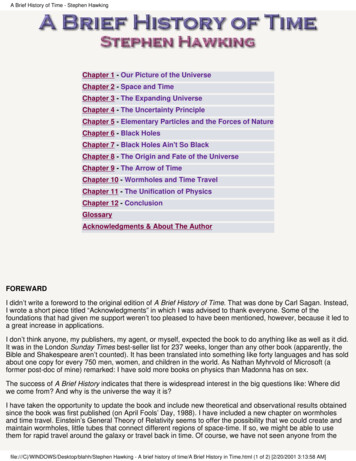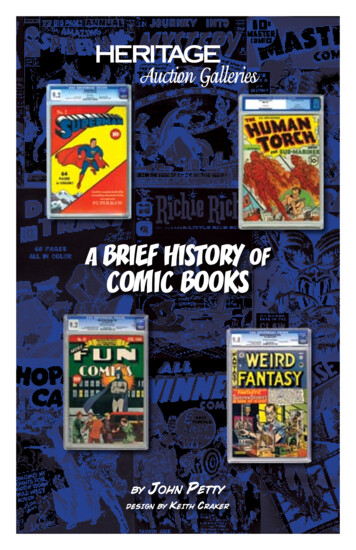
Transcription
A BRIEFHISTORY OFCOMIC BOOKS
ABRIEF HISTORY OF COMIC BOOKSThe Pioneer (1500-1828), Victorian (1828-1883)and Platinum (1883-1938) Ages(Please note: In this article, all dates given for various “Ages” are approximate. With theexception of the beginning of the Golden Age and the beginning of the Silver Age, littleconsensus exists on starting/ending dates. In fact, if you really want to start an argumentbetween comic book geeks, just ask any two of them when the Silver Age ends and theBronze Age begins. Just make sure that you’re standing well back and wearing protectiveclothing when you do, though )Although many comics historians willpoint to European broadsheets of the sixteenth century as the ancient precursors ofcomic books (these broadsheets used textand illustration to get their point across, sothere is some merit to this argument), orsatirical magazines of the 1780s (in whichthe first recorded examples of “dialogueballoons” are seen), most would agree thattrue comics began on May 5, 1895 in the pages of the New York World with the firstappearance of R.F. Outcault’s Hogan’s Alley (which itself may have been inspiredby the turn-of-the-century photography of Jacob Riis or the cartoons of MichaelAngelo Woolf ). This single-panel humor cartoon, which focused on the shenanigansof a group of young hooligans, introduced The Yellow Kid, one of the most popularfictional characters of the first few decades of the 20th Century (by the way, Outcaultis perhaps better known as the creator of Buster Brown, who later lent his name andimage to a line of shoes).Soon, comics became a popular mainstay of newspapers nationwide, and such legendary characters as Happy Hooligan,Maggie & Jiggs (in the popular strip Bringing Up Father), Mutt& Jeff, the Katzenjammer Kids, Krazy Kat & Ignatz Mouse,and Barney Google were born. Although the earliest stripswere all humorous, it didn’t take imaginative creators long torealize that the form could be expanded to accommodate othergenres. Some, like visionary artist Winsor McCay, flourishedin the fantasy field, and brought the odd and surreal to theprinted page in strips like Dreams of a Rarebit Fiend, LittleSammy Sneeze, and, most successfully, Little Nemo in Slumberland. Others exploreda more adventurous route, and soon the likes of Little Orphan Annie, Buck Rogers,The Phantom and Mandrake the Magician were starring in serialized stories on thecomic page.
The Golden Age (1938-1949)It’s generally accepted among collectors that the first comicbook was FUNNIES ON PARADE, published in 1933. Thiswas mainly a collection of newspaper strip reprints, featuringsuch favorites as Mutt & Jeff, Joe Palooka, Hairbreadth Harry,Reg’lar Fellers, and more.But for all intents and purposes, the comic book industryreally started with the publication of ACTION COMICS #1in June 1938. This landmark issue, the first comic to present all-new material, saw the first appearance of The Man ofSteel, Superman. The product of two teenage boys from Cleveland, Ohio, Jerry Siegeland Joe Shuster, Superman was an overnight sensation and forever transformed thefledgling comic book industry. It is the publication of ACTION #1 that marks thebeginning of the “Golden Age” of comics.The reason for Superman’s instant popularity in the late 1930sis obvious: during this time, America was a nation of immigrants. People were coming from all over the world in search of“The American Dream.” Superman, as the last survivor of thedoomed planet Krypton, is the ultimate immigrant. It wasn’tuncommon for children to be separated from their parentsduring this time, either in their home country or once they gotto Ellis Island. This is the feeling, of both adventure and uncertainty, that Siegel and Shuster, both the sons of Europeanimmigrants, tapped into with their strange visitor from another planet.With the success of Superman, a plethora of super-characterswas quickly released to a breathlessly waiting world. Batman,Wonder Woman, the Human Torch, Captain Marvel, theSub-Mariner, Dr. Fate, the Spectre, Captain America theyall donned colorful costumes and waged war against crime andcriminals on the homefront, and, in those patriotic days ofWorld War II, the Nazi menace as well. They fought separately, of course, and also banded together as the Justice Societyof America, the All-Winners Squad, and the Seven Soldiers ofVictory. At their height, superhero comics were selling up to amillion copies per monthly issue. It was a good time to be a hero.And then the war ended, and the heroes who had kept the world safe for democracyfound themselves without worthy enemies to fight. Truly, after triumphing overHitler and his Axis hordes, using those same superpowers to catch bank robbers wassort of like using a tank to swat a fly. The heroes limped on, doing the best they could,until about 1949, but their days were clearly numbered.
The Atomic Age (1949-1956)Comics publishers saw the writing on the walls. Suddenly,everyone was scrambling to find the hot new trend. Lev Gleason had been publishing CRIME DOES NOT PAY since1942, and, a few years later had a blockbuster on his hands.Crime and gangsters were hot! Radio gave us “Dragnet,”“The Shadow,” “The Black Museum,” “Crime Classics,” and“Night Beat,” and comics were quick to jump on the bandwagon. CRIME EXPOSED (1948), TRUE CRIME COMICS (1947), CRIMES BY WOMEN (1948), THE KILLERS(1947), and many, many more crime titles littered the newsstands, fueling the public’s insatiable appetite for “true crime” stories (an appetite thatcontinues unabated to this day. Witness the O.J. Simpson cottage industry and theever-ongoing Jon Benet Ramsey investigation, not to mention the current phenomenon of court TV shows, such as “The People’s Court,” “Judge Judy,” and all theirvarious imitators and competitors). The infusion of this new genre would prove tobe the savior that the comics industry had been looking for. It would also prove tobe its downfall.Another trend in popular culture in the late 40s and early 50s was the horrorfilm, which, in turn, gave birth to the science fiction movie. Horror films had laindormant since the start of World War II. Who cares about vampires and werewolveswhen there’s a real monster to fight in Germany? Avon Publications tried to enterthe horror comics niche in 1946, but EERIE, their sole offering, lasted only oneissue. But by 1949, the war was over, and monsters were making a comeback in bothfilms and comics. 1951 gave us “The Thing.” “It Came From Outer Space,” “WarOf The Worlds,” “Robot Monster” and “Invaders From Mars” terrified us in 1953,“Godzilla” first stomped Tokyo in 1954, and Cold War paranoia reached its height in1956 with “Invasion Of The Body Snatchers.”Comics weren’t slow to notice this trend. William Gaines,the heir to M.C. Gaines, publishing magnate, and head ofEducational (soon to be Entertaining) Comics, found himself presiding over a dying line. PICTURE STORIES FROMTHE BIBLE and FAT & SLAT just weren’t setting the public on fire. So Bill turned to the then-hot genre of crime andpublished CRIME PATROL and WAR AGAINST CRIME.Never one to miss an opportunity, he also helmed SADDLEJUSTICE, GUNFIGHTER, MODERN LOVE, andSADDLE ROMANCES, and a little gem of a parody comiccalled MAD. Then, in the back pages of CRIME PATROL #15, Gaines introducedThe Crypt Keeper, and the Horror Genre in comic books was officially born.
Gaines had some of the most talented artists in the business working for him. JackDavis, Wally Wood, “Ghastly” Graham Ingles, Jack Kamen, Harvey Kurtzman, andAl Williamson, to name just a few, could all be counted on to turn in top-notchstories month after month. And they really took off when the all the stops were pulledout for the horror books.THE VAULT OF HORROR, THE CRYPT OF TERROR,THE HAUNT OF FEAR if it slithered, slimed, crawled,killed, maimed, or devoured, it found a home in the pages ofthese books. No idea was too twisted, no image too terrifyingfor Gaines’ Ghouls to illustrate for a white-knuckled public.“O. Henry”-style twist endings abounded: a baseball playerwho killed a rival was himself killed and his body parts usedto play a midnight ball game. In another, a dutiful wife foundthat her husband, the butcher, had sold tainted meat that hadaccidentally killed their son. Come the next morning, hisremains are proudly displayed in the meat case, while she stands glassy-eyed behindthe counter.And science-fiction wasn’t neglected, either. There were books like WEIRDSCIENCE, WEIRD FANTASY, and INCREDIBLE SCIENCE FICTION.Rockets, spacemen, and a plethora of weird aliens populated these magazines, withall the promise of the newly-born Atomic Age.But then the unthinkable happened. The publication ofSEDUCTION OF THE INNOCENT in 1954 byDr. Frederic Wertham rocked the comic-publishing world.Wertham claimed to be a crusader, obsessed with protectingAmerica’s youth. He claimed to have done a study of juveniledelinquents that “proved” comic books had turned them intocriminals. Never mind that the majority of his subjects camefrom broken homes or from parents who had had unfortunaterun-ins with the law; comic books, and comic books alone,were the scourge of the country and had to be wiped out.Today, a crackpot like Wertham would be laughed out of the media, but, muchlike the infamous “Tail Gunner” Joe McCarthy and his “Red Scare”, people heardWertham’s message and took it to heart. The Supreme Court actually held hearingson comic books, and, as the publisher of the most flagrantly horrific comics, WilliamGaines took the stand. It was not a pretty sight.In response to this incredible threat, and to avoid any kind of government interference, comics publishers banded together and created their own Comics Code, whichspecifically banned, for example, the words “Horror” and “Terror” from the titleof a comic book. It also banned vampires, werewolves, ghouls, zombies, and other
supernatural creatures from the pages of comics literature.This seemed to satisfy Wertham and his allies. There are thosewho say, however conspiratorially, that the Code was designedto put EC, the most successful publisher of the day, out ofbusiness. It all but succeeded.In 1955, grasping at straws, Gaines inaugurated his “NewTrend” line of comics that included titles such as VALOR,ACES HIGH, EXTRA, MD, and PSYCHOANALYSIS, alldesigned to obtain Code-approval. None of them lasted theyear, and, except for a little book called MAD, which had beenconverted to magazine format to avoid the Code, EC went quietly into that goodnight.Comics weren’t dead, however. Over at National Comics, BATMAN, SUPERMAN,and WONDER WOMAN had been plugging along at a time when superheroeswere out of favor. However, now that the Code was in place, and horror and crimecomics were a thing of the past, it seemed like a good time for a resurrection of theheroes of yore.The Silver Age (1956- ca. 1970)Julius Schwartz was a man of many talents. For years he hadbeen an agent for some of the nation’s top science-fictionwriters, including Ray Bradbury, Robert Bloch, and H.P.Lovecraft. By 1956, he was Editor-In-Chief of NationalPeriodical Publications (soon to become DC Comics), whoowned Superman, Batman, and Wonder Woman. Lookingover the bleak comic book landscape of the day, Schwartzdecided that the time was right to bring back the superheroesof yesteryear. Not just bring them back as they were, however,but bring them back updated for a modern age.In the pages of SHOWCASE #4 (cover dated October 1956), Schwartz reintroducedthe Sultan of Speed, the Vizier of Velocity The Flash! After three more try-outs inSHOWCASE, the Flash graduated to his own starring book, and the Silver Age ofComics was born.Hot on the heels of the revitalized Flash came other heroes of the Golden Age,reinterpreted for a savvier audience. Hawkman, Green Lantern, the Atom all werereborn. And then, inevitably, subscribing to the theory that if one is good, moreis better, they all met in the pages of THE JUSTICE LEAGUE OF AMERICA,the greatest gathering of heroes the world had ever known.
Across town, Martin Goodman, publisher of the struggling Atlas/Marvel line ofcomics, wasn’t slow to pick up on this new trend. Atlas had been plugging along sincethe establishment of the Comics Code, turning out lightweight monster yarns aboutsuch Code-approved creatures as Tim-Boo-Bah, Fin Fang Foom, Grootah, Googam,and Metallo. Tight scripts by Stan Lee, and imaginative artwork by Jack Kirby, SteveDitko, Larry Lieber, and others, made these books fun and exciting to read, but theycertainly weren’t setting the world on fire.And then Martin Goodman made a momentous decision: since National had asuccessful superhero team book, Marvel needed one also. Stan Lee was tasked withcreating it.In collaboration with Jack Kirby, Lee produced the first issueof THE FANTASTIC FOUR, which went on sale witha cover date of November 1961. Made up of a quartet ofcharacters who had been exposed to cosmic radiation duringan unauthorized space flight. The group consisted of ReedRichards, the highly elastic Mister Fantastic, Sue Storm, thenow-you-see-her-now-you-don’t Invisible Girl, Johnny Storm,Sue’s brother, a reinterpreted Human Torch, and Ben Grimm,the tragic, monstrous, super-strong Thing.But this wasn’t just any super-group. The FF was a family. They fought amongst eachother, they had no secret identities, they had money and dating problems, and, forthe first couple of issues, they had no colorful costumes. Clearly, these were not yourfather’s superheroes.The Fantastic Four were a smash, and it didn’t take Stan and crew long to capitalizeon their success. Before long, Marvel introduced such icons as Spider-Man, Thor, theHulk, Iron Man, and the X-Men. Comics became hip with the college crowd, and,by about 1964, comic collecting became an increasingly organized hobby.The Silver Age was in full swing. Fueled in part by the burgeoning “Pop Art” movement championed by such influentialartists as Andy War
Although many comics historians will point to European broadsheets of the six-teenth century as the ancient precursors of comic books (these broadsheets used text and illustration to get their point across, so there is some merit to this argument), or satirical magazines of the 1780s (in which the first recorded examples of “dialogue balloons” are seen), most would agree that true comics .
